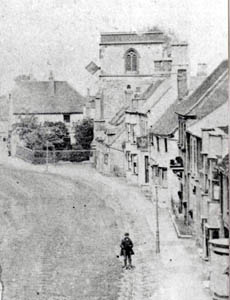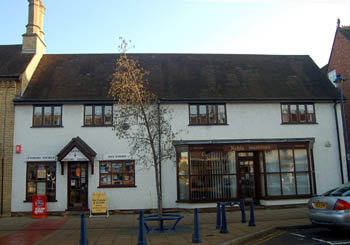The Crown Inn Shefford

Crown about 1870 [Z50/101/14b]
Crown Inn: 19 High Street, Shefford
The history of this former inn goes back at least as far back as 1725 when a warrant was issued at Quarter Sessions for the transport of "the baggage of Lord Cobham's regiment from the Crown Inn, Shefford to Buntingford, Hertfordshire".
In 1805 James la Porte (as great great nephew of Charles Milward of Fielden, gentleman), was owner of the Crown "formerly the Red Lion". This creates a slight problem because the only reference we have to a Red Lion in Shefford comes whenThomas Pateman, collar maker, leased the property "known as the Red Lion" from the Robert Lucas Feoffment Estate for 9 years from 24 March 1732 [X465/319]; Thomas Pateman died in 1764, his will [ABP/W1764/42] indicating that he was still in business as an innholder.
This means that either Charles Milward purchased the Red Lion from the Robert Lucas charity or that there were two inns in Shefford known as the Red Lion at different times, a reasonably common event in market towns. At any rate, in 1805 James la Porte conveyed the Crown to its tenant, John Phipps of Shefford, brewer [WJ377-378]. Four years later, however, he conveyed it to Hitchin brewers William and Joseph Lucas [WJ379-380].
The Bedfordshire Times of 26th April 1856 records the following case at the Biggleswade Petty Sessions: "Deficient measures: Charles Hare, of the Crown Inn, Shefford, was charged by E.Blunden, inspector of weights & measures, with having in his possession one quart and four pint pots short measure. Fined 11s, including costs. Paid."
The licensing register of 1872 [HF143/1] notes that the Crown was then owned by Charles Balding of Shefford, who had, presumably, purchased it from the Lucas brothers. The inn was obviously not very profitable, however, as it closed in 1873.
In 1927 the town of Shefford was valued under the Rating Valuation Act 1925; every piece of land and building in the country was assessed to determine the rates to be paid on it. The valuer visiting 19 and 21 High Street (then all one pemises) noted [DV1/C289/47] that the occupier was H.Green [the business was known as Annie Green and Son] and the owner Saint Francis' Home, who used the business, along with others, as instruction for its boys. The premises was constructed of roughcast and tile and comprised downstairs a living room and kitchen, a cobbler's shop 8 feet by 8 feet 6 inches, a shop 15 feet by 10 feet and a boot shop 12 feet 6 inches by 13 feet 6 inches. Upstairs were two bedrooms and a sitting room. Outside were a large wood and tile barn, a glass potting shed and a timber fowl house measuring 10 feet by 32 feet, timber fowl houses and runs and a small garage. The valuer noted: "End piece derelict" which presumably refers to the modern 21 High Street.
In 1979 19-21 High Street was listed by the former Department of Environment as Grade II, of special interest. They considered the properties to be 16th century with 19th century alterations. They are constructed of substantial timber-framing with a colourw-washed roughcast over the top; the roofs are steeply pitched and have concrete tiles. The Department noted: "No.19 interior retains some early panelling to first floor". At the time of writing [2008] 19 High Street is a shop selling fishing tackle and bait.

Former Crown Public House February 2008
Document References:
- QSR1725: warrant for regimental transport: 1725;
- X465/319: lease for 9 years by Thomas Pateman: 1732;
- ABP/W1764/42: will of Thomas Pateman: 1764;
- WJ377-378: Crown conveyed by James la Porte to John Phipps: 1805;
- WJ379-380: Crown conveyed by John Phipps to William and Joseph Lucas: 1809;
- CLP13: register of alehouse licences: 1822-1828;
- ABP/W1845/40: will of James Parrott: 1845;
- Bedfordshire Times: landlord fined for short measures: 1856;
- HF143/1: Register of Alehouse Licences - Biggleswade Petty Sessional Division: 1872-1873
List of Licensees:
Note that this is not a complete list ; entries in italics refer to licensees where either beginning or end, or both, dates are not known:
1731-1764: Thomas Pateman;
Ann Archer;
John Matthews;
William Rawlins;
1805: John Phipps;
1809: William Dickens;
1822-1845: James Parrott;
1853-1854: William Tingey;
1856: Charles Hare;
1861-1873: James Bentley
Inn closed 27th August 1873